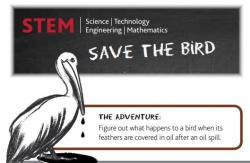Search for Resources
Description
Save the Birds teaches students what happens to a bird when its feathers are covered in oil after a spill. Through a hands-on simulation, students explore how birds are affected by oil and how wildlife rescuers help oiled birds. Students will dip feathers in oil to simulate the oil spill. They will then try to clean them with water and dish soap.
Students will:
- explain how bird feathers are affected by natural oils and oil from oil spills
- describe how humans remove oil from birds’ feathers and the effects that process has on birds’ ability to fly
General Assessment
What skills does this resource explicitly teach?
- Critical Thinking Skills
- Analyzing
- Understanding
Strengths
- The resource is based on an experiment to make students understand the consequences that affect fauna during an oil spill.
- An online resource is available to share other means used by scientists to help birds after an oil spill.
Weaknesses
- Information and documentation on the subject are not available to the teacher.
- The resource does not present a real case where an oil spill occurred and the birds were rescued.
Recommendation of how and where to use it
Save the Bird is an easy to implement resource geared for younger students. Whether part of a larger study on habitats or an introductory lesson for wildlife protection this resource is an excellent fit for science outcomes.
Relevant Curriculum Units
The following tool will allow you to explore the relevant curriculum matches for this resource. To start, select a province listed below.
- Step 1Select a province
- Alberta
- British Columbia
- Step 2Select a grade level
- Grade 3
- Step 3Select a subject
- Science
- Step 4Relevant matches
- Science 3: Living things are diverse, can be grouped, and interact in their ecosystems
- Grade 4
- Step 3Select a subject
- Science
- Step 4Relevant matches
- Science 4: All living things sense and respond to their environment
- Manitoba
- Newfoundland & Labrador
- Northwest Territories
- Step 2Select a grade level
- Grade 2
- Step 3Select a subject
- Science
- Step 4Relevant matches
- Life Science: Growth and Changes in Animals
- Grade 4
- Step 3Select a subject
- Science
- Step 4Relevant matches
- Life Systems: Habitats & Communities
- Science 4: All living things sense and respond to their environment
- Grade 6
- Step 3Select a subject
- Science
- Step 4Relevant matches
- Life Systems: Diversity of Living Things
- Nova Scotia
- Nunavut
- Ontario
- Step 2Select a grade level
- Grade 2
- Step 3Select a subject
- Science & Technology
- Step 4Relevant matches
- Life Systems: Growth & Changes in Animals
- Grade 6
- Step 3Select a subject
- Science & Technology
- Step 4Relevant matches
- Life Systems: Biodiversity
- Prince Edward Island
- Step 2Select a grade level
- Grade 2
- Step 3Select a subject
- Science
- Step 4Relevant matches
- Animal Growth and Changes:Investigating the Needs and Life Cycles of an Organism
- Grade 4
- Step 3Select a subject
- Science
- Step 4Relevant matches
- Habitats
- Grade 6
- Step 3Select a subject
- Science
- Step 4Relevant matches
- Diversity of Life
- Quebec
- Step 2Select a grade level
- Grade 2
- Step 3Select a subject
- Science & Technology
- Step 4Relevant matches
- Living things
- Grade 3
- Step 3Select a subject
- Science & Technology
- Step 4Relevant matches
- Living Things
- Grade 4
- Step 3Select a subject
- Science & Technology
- Step 4Relevant matches
- Living Things
- Grade 5
- Step 3Select a subject
- Science & Technology
- Step 4Relevant matches
- Living Things
- Grade 6
- Step 3Select a subject
- Science & Technology
- Step 4Relevant matches
- Living Things
- Saskatchewan
- Yukon Territory
Themes Addressed
Ecosystems (2)
- Appreciating the Natural World
- Wildlife Protection
Waste Management (1)
- Liquid Waste

